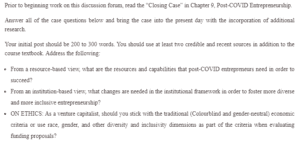Post-COVID Entrepreneurship and Funding
Individuals need to take risks and desire success; no risk without reward, right? The closing case presents two differing thoughts on entrepreneurship in the post-COVID era. The first view is grim, where small and medium businesses face global economic restraints with reduced consumption and investments. Many companies shut down during COVID or had trouble keeping afloat. This viewpoint encourages employment in established organizations and holding off on new business ventures. Peng (2023) suggest that a lack of willingness to take risk negatively affects entrepreneurs from starting businesses. The second viewpoint is that a recent business rise will emerge from the slump. The pandemic resulted in a boom in personal protective equipment, food delivery, and online services.
Developing an environment that encourages entrepreneurship through formal and informal education with the help of additional resources is critical to successful entrepreneurs. Joseph Schumpeter coined the phrase “creative destruction,” meaning the destruction of things creates opportunities for others (Peng, 2023). The article also refers to a structural loosening that washes away inefficient and uncompetitive businesses but leads to new entrepreneurial opportunities.
COVID opened new electronic opportunities to conduct business that many companies still use regularly. The same technology also increases individuals’ abilities to gain access to formal education through online portals. Industry-specific training and continuing education help younger employees gain access to knowledge and understanding of their specific trade; it then creates opportunities to climb the ladder, move vertically into another position at another organization, or develop an idea for a new business. Entrepreneurs can increase their knowledge through formal education, industry-specific training, and continuing education.
Informal education and services include Mentoring, networking, self-education, access to capital, and other support systems. Utilizing a mentor with experience in the same industry helps transfer decades of institutional knowledge to driven, talented newcomers (Paradise, n.d.). Mentors can help individuals learn from their mistakes, and they also help guide individuals when they make their own mistakes. They can also introduce them to additional business partners; this helps build a business support system and ways to network with other like-minded individuals. Family, friends, and peers can also provide a support system essential to an entrepreneur’s motivations.
Support from individuals who have built a rapport is necessary, providing emotional support in the business venture. The Small Business Association (SBA) provides financial assistance for education, industry-specific training, access to capital, marketing assistance, business development, and operational support (Office of Entrepreneurship Education, n.d.). Taking advantage of nontangible things such as networking, self-education, and other support systems allows individuals to navigate the complexity of business and build relationships with like- minded entrepreneurs.
From an institutional standpoint, supporting more diverse and inclusive entrepreneurship requires shifts that level the playing field for marginalized groups. This could include policies that address discrimination, improve access to education and training, promote equal opportunities in hiring, and allocate resources to support multicultural entrepreneurs.
Additionally, efforts to raise awareness and understanding of the benefits of diversity and inclusivity in entrepreneurship and the barriers faced by underrepresented groups. Creating a more varied and inclusive entrepreneurial environment would need a comprehensive approach from engaging participants from all socioeconomic levels and sectors.
Creating opportunities for different cultures and ideas to flourish fosters a more diverse and inclusive entrepreneurship atmosphere. Pixar believes diversity is vital to their creativity. It promotes a culture of inclusivity and collaboration where all employees, regardless of job title or hierarchy, feel empowered to contribute to the creative process (Harvard Business Review, 2008). Uniting individuals of different backgrounds and perspectives will lead to a more collaborative and unified result, which is better for the organization’s success. In addition, venture capitalists promote a more diverse, inclusive entrepreneurial environment by including diversity and inclusivity in funding decisions, leading to better outcomes for all with vested interests.
References
Harvard Business Review. (2008). How Pixar Fosters Collective Creativity. https://hbr.org/2008/09/how-pixar-fosters-collective-creativity
Office of Entrepreneurship Education. (n.d.). https://www.sba.gov/about-sba/sba- locations/headquarters-offices/office-entrepreneurship-education
Paradise, A. (n.d.). Why mentorship is essential for entrepreneurs. Forbes. https://www.forbes.com/sites/forbesbusinesscouncil/2020/02/13/why-mentorship-is- essential-for-entrepreneurs/?sh=5f2346f97e6b
Peng, M. W. (2023). Global business. Cengage Learning.
ORDER A PLAGIARISM-FREE PAPER HERE
We’ll write everything from scratch
Question
Prior to beginning work on this discussion forum, read the “Closing Case” in Chapter 9, Post-COVID Entrepreneurship.

Post-COVID Entrepreneurship and Funding
Answer all of the case questions below and bring the case into the present day with the incorporation of additional research.
Your initial post should be 200 to 300 words. You should use at least two credible and recent sources in addition to the course textbook. Address the following:
- From a resource-based view, what are the resources and capabilities that post-COVID entrepreneurs need in order to succeed?
- From an institution-based view, what changes are needed in the institutional framework in order to foster more diverse and more inclusive entrepreneurship?
- ON ETHICS: As a venture capitalist, should you stick with the traditional (Colourblind and gender-neutral) economic criteria or use race, gender, and other diversity and inclusivity dimensions as part of the criteria when evaluating funding proposals?
Your post must be organized using APA Style headings as outlined in the APA Style ElementsLinks to an external site. Resource.


